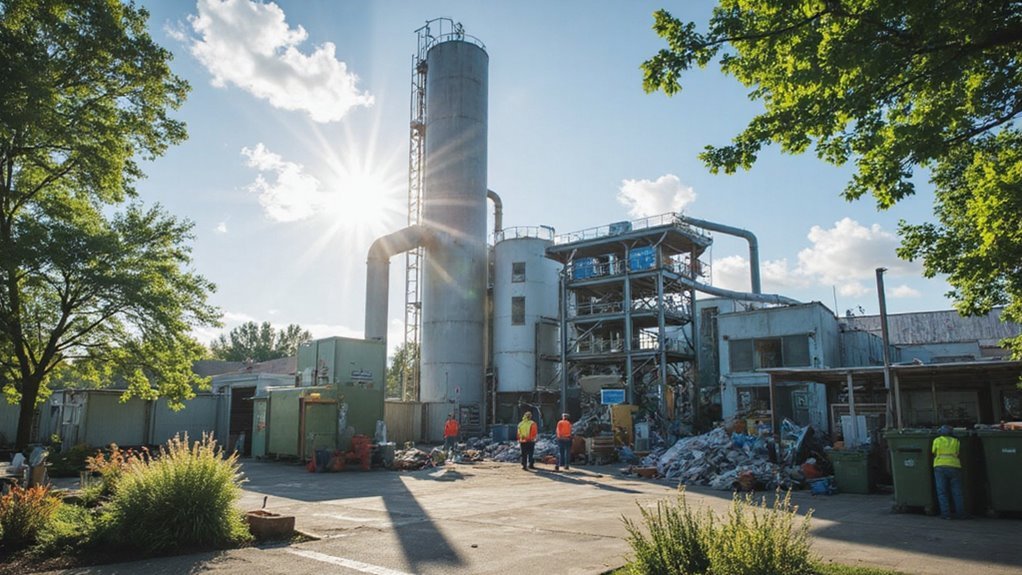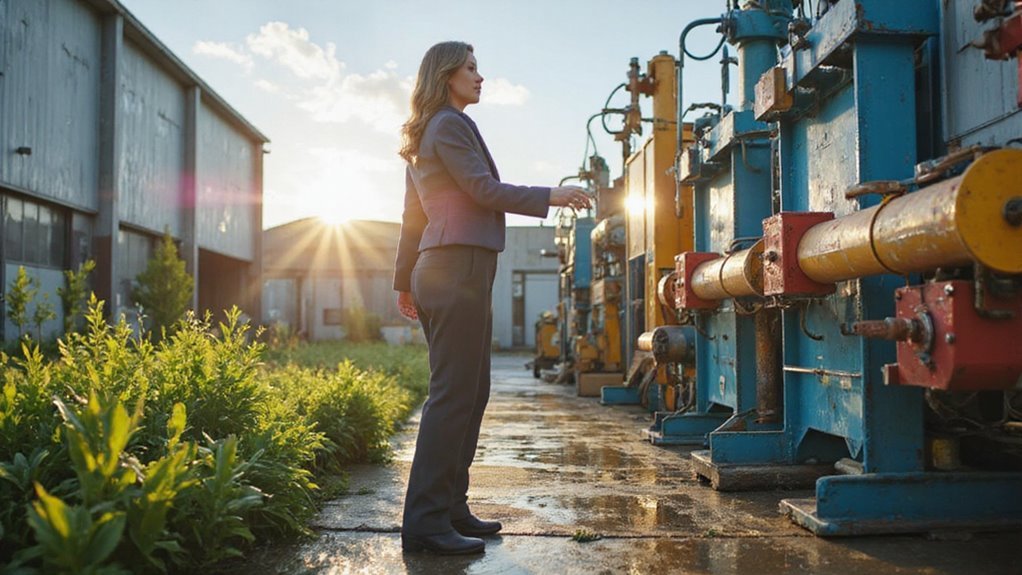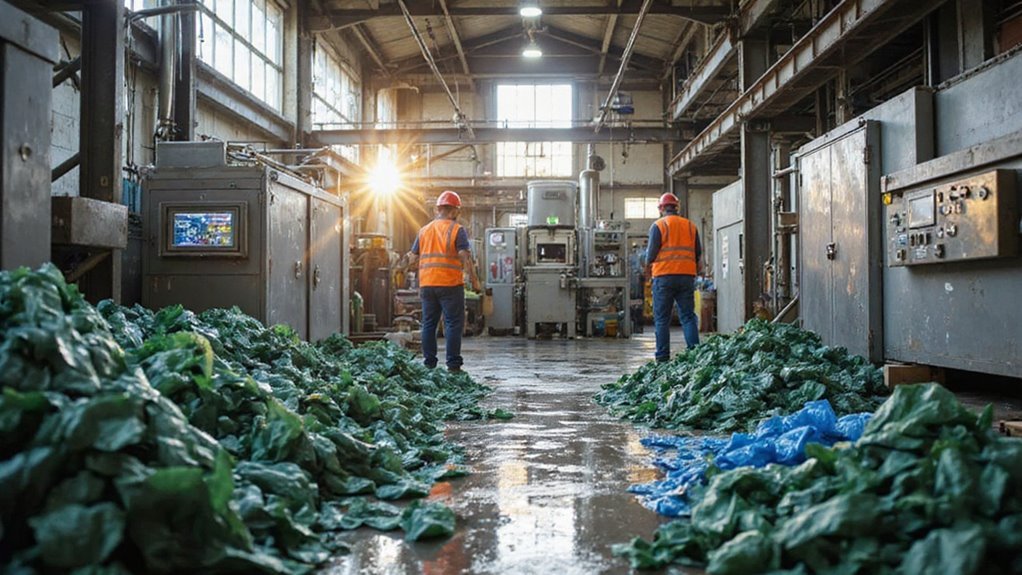Want to enhance your ROI while going zero-waste? Start with a solid waste audit to identify hidden savings and recyclable gold. Financing recycling equipment through leases or loans saves upfront cash and elevates cash flow—plus, government perks like IRS Section 179 can sweeten the deal. Choose energy-smart machines that cut costs and support your green goals. Train your team well, and watch your waste worries shrink into profit. Keep going, and you’ll realize how to turn sustainability into a real business advantage.
Key Takeaways
- Conduct a waste audit to identify recyclable materials and hidden costs, improving equipment selection and reducing disposal expenses by up to 30%.
- Choose energy-efficient recycling machines to lower maintenance costs and improve operational efficiency, cutting energy use by up to 30%.
- Leverage financing options like leases, loans, and grants, along with government incentives and IRS Section 179 deductions to optimize cash flow and ROI.
- Develop a solid business plan with clear cash flow projections and showcase recycling partnerships to improve financing approval chances.
- Invest in team training and expert partnerships to maintain equipment performance, track efficiency, and adapt strategies for continuous improvement.
Building Your Business Case for Sustainable Growth

Let’s start by revealing the hidden costs in your waste stream—you might be surprised at what’s slipping through the cracks. A solid waste audit gives you the facts to make smart choices, turning guesswork into dollars saved. Additionally, don’t underestimate the power behind your brand’s green cred; quantifying sustainability’s financial value can make your business shine brighter than just cost-cutting ever could. Leveraging financing for bio-based products can further support your profitability while reinforcing your commitment to eco-friendly business practices.
A Framework for Your Waste Audit: Uncovering Hidden Costs
When you dig into a waste audit, you’re not just poking around for forgotten trash—you’re revealing hidden treasure that could seriously improve your bottom line. A smart waste audit identifies recyclable materials, reducing disposal costs by up to 30% and discovering new revenue streams through recycling equipment. This also helps you align with zero-waste growth strategies, cutting waste volumes and shrinking your environmental footprint.
| Audit Focus | Benefit |
|---|---|
| Waste Composition | Identify recyclable gold |
| Cost Breakdown | Find savings up to 30% |
| Regulatory Risks | Avoid penalties |
| Material Repurposing | Improve sustainability cred |
This structure turns your waste into profit and drives your zero-waste growth expedition. Ready to see what’s lurking in your bins?
The Brand Asset: Quantifying the Financial Value of Sustainability
After revealing the hidden gold within your waste audit, it’s time to highlight how sustainability can actually improve your bottom line. Embracing sustainable practices isn’t just good for the planet—it’s a savvy business move that elevates financial viability. When you invest in recycling equipment, you’re not just cutting costs; you’re creating a measurable return in investment by reducing production expenses and tapping into growing consumer demand for eco-friendly brands. Additionally, government incentives and stricter waste regulations work in your favor, making recycling technologies even more financially attractive. Don’t underestimate the power of sustainability as a brand asset—it boosts reputation, draws in loyal customers, and future-proofs your business. So go ahead, turn your green goals into green gains!
Securing the Capital for Your Recycling Equipment Investment

Securing the right capital isn’t just about crunching numbers—it’s about choosing the best fit for your business, whether that’s a loan, lease, or even a grant that feels like free money. You’ll need insider strategies for getting your application approved without pulling out your hair, and trust me, those tips can make all the difference. Let’s break down your financing options so you can fund your zero-waste goals without the guesswork or stress. Consider using a business line of credit to access flexible funding tailored to varying capital needs in your recycling equipment investments.
The Financing Matrix: Comparing Loans, Leases, and Grant Solutions
Although investing in recycling equipment feels like stepping into a maze within confusing options, understanding how loans, leases, and grants stack up can make your decision a lot clearer. When considering financing, loans often demand collateral and stricter approvals—think of them as the credit check overachievers—while leases let you use equipment with less hassle and zero upfront cash, keeping your balance sheet happy. Grants sound like a free lunch, but they come wrapped in competitive, slow applications, usually favoring nonprofits or government projects. Smart players utilize IRS Section 179 deductions to cut costs further. So, while loans and leases battle it out regarding access and cash flow benefits, grants might be the wildcard—if you have the patience. Maneuvering through this matrix helps you pick the smartest path for powering your zero-waste growth.
Get Your Application Approved: Insider Strategies from Financial Lenders
Getting your application approved for recycling equipment financing isn’t just about filling out forms and hoping for the best—it’s about playing smart and showing lenders you mean business. To get financial lenders to approve applications, focus on creating a solid business plan with clear cash flow projections and ROI estimates. Approach specialty financing options customized for the recycling sector—they know your market and can expedite approvals. Don’t forget to highlight any current recycling partnerships or contracts; demonstrating demand makes your case stronger. In addition, leveraging IRS Section 179 benefits to deduct equipment costs can sweeten the deal. Building relationships with lenders experienced in recycling financing isn’t just networking—it’s your secret weapon to secure capital and accelerate your zero-waste growth path.
Selecting High-Performance Equipment for Maximum Profitability

You’ll want equipment that fits your waste like a glove—no point in buying a baler if cardboard isn’t your main culprit. Modern, cost-effective recycling tech not only munches through materials more swiftly but also keeps maintenance headaches at bay. And remember, think long-term: picking gear that grows with your business means you won’t be stuck upgrading when your zero-waste goals outpace your machine.
Match Equipment to Your Unique Waste Stream
When you tailor recycling equipment to fit your unique waste stream, you set yourself up for a smoother, more profitable operation—kind of like finding the perfect pair of shoes that fit just right. Choosing equipment that matches your materials—be it plastics, metals, or organics—boosts sorting efficiency and cuts contamination, which directly lifts your profitability. Additionally, energy-efficient machines don’t just save in maintenance costs; they also shout sustainability to customers and investors alike. The right gear handles fluctuating waste volumes smoothly, letting you seize market opportunities without breaking a sweat. So, instead than one-size-fits-all, think customized innovation—it’s the secret sauce turning waste headaches into sustainable revenue streams while keeping your brand sharp and your wallet happy.
Modern, Cost-effective Recycling Technology
Although upgrading your recycling equipment might sound like a big leap, investing in modern, cost-effective technology can seriously pay off by slashing your operational costs and enhancing efficiency. Modern recycling machines, like high-performance balers and compactors, work smarter—not harder—cutting energy use by as much as 30% compared to older models. They help you reclaim precious materials like aluminum, saving huge energy and increasing profits. Additionally, efficient technology supports your zero-waste goals while tapping into growing markets for recyclables. Incentives like tax credits can ease the upfront cost, making the investment even sweeter. So, don’t let outdated gear hold you back—embrace modern recycling technology to maximize your ROI and keep your business thriving sustainably and profitably.
Future-Proofing Your Purchase: A Long-Term Viability Analysis
Since your recycling equipment is a long-term investment, picking the right high-performance machine is like choosing a trusty sidekick for your zero-waste mission—it needs to keep up and keep working without costly hiccups. Focusing upon long-term profitability means investing in technology that enhances efficiency and resilience. Here’s how to future-proof your purchase:
- Choose electric or hybrid machines for lower maintenance and steady costs, avoiding surprise breakdowns.
- Look for models with strong material recovery rates—these recycling operations generate revenue, offsetting your upfront expenditure.
- Factor in upcoming environmental regulations; compliant equipment saves you penalties and elevates market appeal.
From Implementation to Profit Center: An Operational Guide
You’re about to turn your new recycling gear from pricey machines to hardworking profit centers, but let’s face it—this shift isn’t without its traps. Avoiding common mistakes, like underestimating waste volume or getting locked into a bad financing deal, can save you headaches and dollars down the line. Think of this guide as your manager’s cheat sheet for steering clear of bumps while cruising toward zero-waste success.
Mitigating Risk: A Manager’s Guide to Avoiding Common Pitfalls
When you decide regarding bringing recycling equipment at the site, this is easy for you to focus regarding the shiny promise concerning cost savings and extra revenue—and overlook the bumps which can slow you down. To keep your sustainable investment in line, here’s how to dodge common pitfalls:
- Execute a thorough waste audit initially—know what you’re really dealing with so your recycling plan matches actual needs.
- Train your team well; even the snazziest compactor won’t save you if it’s misused or ignored.
- Partner with recycling pros who can tailor strategies and keep your equipment humming efficiently.
Frequently Asked Questions
How Do Recycling Equipment Maintenance Costs Affect Overall ROI?
Maintenance costs can make or break your ROI—keeping your recycling equipment in prime shape prevents costly downtime and repairs. You’ll dodge a bullet by budgeting for upkeep, ensuring your investment keeps innovating profitably over time.
Can Financing Options Include Bundled Training and Support Services?
Yes, many financing options bundle training and support services, so you’ll become proficient with your new equipment quickly and minimize downtime. The integrated approach guarantees smooth operations and maximizes your ROI while embracing innovative waste management solutions.
What Tax Incentives Exist for Investing in Recycling Equipment?
You can tap into tax credits like the 45L credit, offering up to $2,000 per dwelling for energy-efficient improvements, in addition to accelerated depreciation for recycling equipment. These incentives slash costs, making innovation more affordable and enhancing your bottom line.
How Does Equipment Choice Impact Workplace Safety Compliance?
Choosing the right recycling equipment reduces workplace hazards by minimizing manual handling and overflowing waste. You’ll stay compliant with safety regulations, improve employee well-being, and maintain operational flow—all while embracing innovative, efficient waste management solutions.
What Are Best Practices for Handling Fluctuating Commodity Prices?
You’ll want to diversify your recyclable materials, monitor market trends constantly, and time sales strategically. Stay flexible with modular equipment to adapt capacity, and build financial models prioritizing cost savings over variable commodity revenues to minimize risk.






